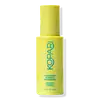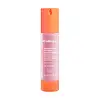What's inside
What's inside
 Key Ingredients
Key Ingredients

 Benefits
Benefits

 Concerns
Concerns

 Ingredients Side-by-side
Ingredients Side-by-side

Water
Skin ConditioningCaprylic/Capric Triglyceride
MaskingGlycerin
Humectant3-O-Ethyl Ascorbic Acid
Skin ConditioningNiacinamide
SmoothingPanthenol
Skin ConditioningSodium Hyaluronate
HumectantCitrus Medica Vulgaris Fruit Extract
AntioxidantTetrahexyldecyl Ascorbate
AntioxidantLens Esculenta Fruit Extract
Skin ConditioningPyrus Malus Fruit Extract
Skin ConditioningAverrhoa Carambola Fruit Extract
Skin ConditioningCamellia Sinensis Leaf Extract
AntimicrobialCitrus Aurantium Amara Leaf/Twig Oil
MaskingCitrus Aurantium Bergamia Peel Oil
Citrus Limon Peel Oil
MaskingIlex Paraguariensis Leaf Extract
PerfumingTocopherol
AntioxidantTriethyl Citrate
MaskingIsosorbide Dicaprylate
Skin ConditioningHexylresorcinol
AntimicrobialSclareolide
MaskingSodium Lactate
BufferingSodium PCA
HumectantSorbitol
HumectantPolyglyceryl-10 Laurate
Skin ConditioningAmmonium Acryloyldimethyltaurate/Vp Copolymer
Propylene Glycol
HumectantPhenoxyethanol
PreservativePotassium Sorbate
PreservativeHexenyl Acetate
MaskingIonone
AstringentSodium Benzoate
MaskingLimonene
PerfumingLinalool
PerfumingCitral
PerfumingCI 17200
Cosmetic ColorantCI 19140
Cosmetic ColorantWater, Caprylic/Capric Triglyceride, Glycerin, 3-O-Ethyl Ascorbic Acid, Niacinamide, Panthenol, Sodium Hyaluronate, Citrus Medica Vulgaris Fruit Extract, Tetrahexyldecyl Ascorbate, Lens Esculenta Fruit Extract, Pyrus Malus Fruit Extract, Averrhoa Carambola Fruit Extract, Camellia Sinensis Leaf Extract, Citrus Aurantium Amara Leaf/Twig Oil, Citrus Aurantium Bergamia Peel Oil, Citrus Limon Peel Oil, Ilex Paraguariensis Leaf Extract, Tocopherol, Triethyl Citrate, Isosorbide Dicaprylate, Hexylresorcinol, Sclareolide, Sodium Lactate, Sodium PCA, Sorbitol, Polyglyceryl-10 Laurate, Ammonium Acryloyldimethyltaurate/Vp Copolymer, Propylene Glycol, Phenoxyethanol, Potassium Sorbate, Hexenyl Acetate, Ionone, Sodium Benzoate, Limonene, Linalool, Citral, CI 17200, CI 19140
Water
Skin ConditioningCitrus Aurantium Dulcis Flower Water
Skin ConditioningCaprylic/Capric Triglyceride
MaskingHydrogenated Polydecene
EmollientGlycerin
HumectantCetearyl Alcohol
EmollientPropanediol
SolventGlyceryl Stearate
EmollientSorbitan Stearate
EmulsifyingPolysorbate 60
EmulsifyingCitrus Aurantium Dulcis Peel Oil
MaskingBetaine
HumectantPhenoxyethanol
PreservativeTocopheryl Acetate
AntioxidantCarbomer
Emulsion StabilisingArginine
Masking1,2-Hexanediol
Skin ConditioningAllantoin
Skin ConditioningFerulic Acid
AntimicrobialDisodium EDTA
Ethylhexylglycerin
Skin ConditioningSodium Hyaluronate
HumectantAscorbic Acid
AntioxidantLactic Acid
BufferingSalix Alba Bark Extract
AstringentBifida Ferment Lysate
Skin ConditioningTocopherol
AntioxidantCitral
PerfumingLimonene
PerfumingWater, Citrus Aurantium Dulcis Flower Water, Caprylic/Capric Triglyceride, Hydrogenated Polydecene, Glycerin, Cetearyl Alcohol, Propanediol, Glyceryl Stearate, Sorbitan Stearate, Polysorbate 60, Citrus Aurantium Dulcis Peel Oil, Betaine, Phenoxyethanol, Tocopheryl Acetate, Carbomer, Arginine, 1,2-Hexanediol, Allantoin, Ferulic Acid, Disodium EDTA, Ethylhexylglycerin, Sodium Hyaluronate, Ascorbic Acid, Lactic Acid, Salix Alba Bark Extract, Bifida Ferment Lysate, Tocopherol, Citral, Limonene
Ingredients Explained
These ingredients are found in both products.
Ingredients higher up in an ingredient list are typically present in a larger amount.
This ingredient is an emollient, solvent, and texture enhancer. It is considered a skin-softener by helping the skin prevent moisture loss.
It helps thicken a product's formula and makes it easier to spread by dissolving clumping compounds.
Caprylic Triglyceride is made by combining glycerin with coconut oil, forming a clear liquid.
While there is an assumption Caprylic Triglyceride can clog pores due to it being derived from coconut oil, there is no research supporting this.
Learn more about Caprylic/Capric TriglycerideCitral is a fragrance and used to add a lemon-like scent to products. It is both naturally found in plants and created synthetically. In plants, it is commonly occurring in lemon myrtle, lemongrass, lemon tea-tree, lemon verbena, and other citruses.
The EU mandates Citral be listed separately as a fragrance. It is a known allergen and may cause contact dermatitis. Citral can also used as a masking ingredient.
The term 'fragrance' is not regulated in many countries. In many cases, it is up to the brand to define this term. For instance, many brands choose to label themselves as "fragrance-free" because they are not using synthetic fragrances. However, their products may still contain ingredients such as essential oils that are considered a fragrance.
The term 'citral' is a collective term for two geometric isomers: geranial/Citral A and neral/Citral B.
Learn more about CitralGlycerin is already naturally found in your skin. It helps moisturize and protect your skin.
A study from 2016 found glycerin to be more effective as a humectant than AHAs and hyaluronic acid.
As a humectant, it helps the skin stay hydrated by pulling moisture to your skin. The low molecular weight of glycerin allows it to pull moisture into the deeper layers of your skin.
Hydrated skin improves your skin barrier; Your skin barrier helps protect against irritants and bacteria.
Glycerin has also been found to have antimicrobial and antiviral properties. Due to these properties, glycerin is often used in wound and burn treatments.
In cosmetics, glycerin is usually derived from plants such as soybean or palm. However, it can also be sourced from animals, such as tallow or animal fat.
This ingredient is organic, colorless, odorless, and non-toxic.
Glycerin is the name for this ingredient in American English. British English uses Glycerol/Glycerine.
Learn more about GlycerinLimonene is a fragrance that adds scent and taste to a formulation.
It's found in the peel oil of citrus fruits and other plants such as lavender and eucalyptus. The scent of limonene is generally described as "sweet citrus".
Limonene acts as an antioxidant, meaning it helps neutralize free radicals.
When exposed to air, oxidized limonene may sensitize the skin. Because of this, limonene is often avoided by people with sensitive skin.
The term 'fragrance' is not regulated in many countries. In many cases, it is up to the brand to define this term. For instance, many brands choose to label themselves as "fragrance-free" because they are not using synthetic fragrances. However, their products may still contain ingredients such as essential oils that are considered a fragrance.
Learn more about LimonenePhenoxyethanol is a preservative that has germicide, antimicrobial, and aromatic properties. Studies show that phenoxyethanol can prevent microbial growth. By itself, it has a scent that is similar to that of a rose.
It's often used in formulations along with Caprylyl Glycol to preserve the shelf life of products.
Sodium Hyaluronate is hyaluronic acid's salt form. It is commonly derived from the sodium salt of hyaluronic acid.
Like hyaluronic acid, it is great at holding water and acts as a humectant. This makes it a great skin hydrating ingredient.
Sodium Hyaluronate is naturally occurring in our bodies and is mostly found in eye fluid and joints.
These are some other common types of Hyaluronic Acid:
Learn more about Sodium HyaluronateTocopherol (also known as Vitamin E) is a common antioxidant used to help protect the skin from free-radicals and strengthen the skin barrier. It's also fat soluble - this means our skin is great at absorbing it.
Vitamin E also helps keep your natural skin lipids healthy. Your lipid skin barrier naturally consists of lipids, ceramides, and fatty acids. Vitamin E offers extra protection for your skin’s lipid barrier, keeping your skin healthy and nourished.
Another benefit is a bit of UV protection. Vitamin E helps reduce the damage caused by UVB rays. (It should not replace your sunscreen). Combining it with Vitamin C can decrease sunburned cells and hyperpigmentation after UV exposure.
You might have noticed Vitamin E + C often paired together. This is because it is great at stabilizing Vitamin C. Using the two together helps increase the effectiveness of both ingredients.
There are often claims that Vitamin E can reduce/prevent scarring, but these claims haven't been confirmed by scientific research.
Learn more about TocopherolWater. It's the most common cosmetic ingredient of all. You'll usually see it at the top of ingredient lists, meaning that it makes up the largest part of the product.
So why is it so popular? Water most often acts as a solvent - this means that it helps dissolve other ingredients into the formulation.
You'll also recognize water as that liquid we all need to stay alive. If you see this, drink a glass of water. Stay hydrated!
Learn more about Water